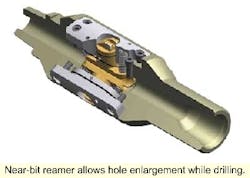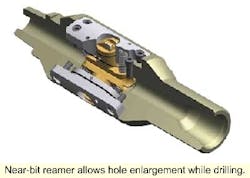DRILLING TECHNOLOGY: Near-bit reamer eliminates typical backreaming situations in case studies
In high-cost extended reach drilling, deepwater, and high pressure wells, a safe and efficient under-reaming job can economically resolve a number of costly well problems. When conditions such as moving salts or shale, cuttings bed buildup, and excessive cake formation compromise hole quality, or when there is a need to enlarge wellbore size beyond the drill bit diameter, Security DBS claims its near-bit reamer (NBR) can provide an alternative to conventional hole enlargement operations.
Typically positioned directly above the bit, the tool enables the borehole to be opened as it is drilled, eliminating the need to trip and change the bottomhole assembly (BHA), according to the firm. On recent offshore runs, the tool was used with a rotary steerable drilling assembly to open a 12-1/4 in. hole to 13 in. while drilling through swelling formations.
Normally, after drilling the hole section in such an application, backreaming is necessary. In some instances, backreaming has been required all the way to the casing shoe. However, success in producing a larger annulus diameter which reduced, and in some cases eliminated, the need for backreaming has been achieved. This saved rig time and additional clearance to run subsequent casing strings.
Design, operation
The tool enables a rotary steerable system to be used for drilling oversized holes. It can be positioned anywhere on the BHA with minimal influence on steerability to enlarge a hole without interrupting drilling. In addition to reduced drillstring-tripping and handling times, Security DBS claims that the savings from reduced hole problems can also be significant.
The tool is manufactured in seven sizes, with hole opening ranges from 4-3/4 in. to 5-1/4 in., to as much as 17-20 in. In operation, the tool is similar to a three-bladed near-bit stabilizer. It is activated by hydraulic force to open three cutter arms, which move radially outward when a pressure drop below the tool causes activation. Pressure acting on the flanges forces the arms open. Springs are used to retract the arms. The manufacturer says there is no locking mechanism to jam or malfunction, and shear pins allow it to be run dormant or closed in order to allow it to drill out of the casing shoe.
The bit can be used in a number of different BHA configurations, including rotary BHA, rotary steerable BHA, and steerable PDM BHA. In addition, it can be used as a full gauge stabilization up the BHA to provide enhanced centralization for good quality well logs, the manufacturer states.
Three contact points create a centric drilling action that holds the BHA in the normal center of the hole. This centralization reduces BHA vibration, fatigue, and measurement while drilling/logging while drilling failures. In terms of steerability, the tool requires a lower bend to achieve high dogleg severity, reducing slide times in some applications from 90% to just over 20%. Since there is little effect on rate of penetration (ROP), the net result can be an increase in cost savings.
Reaming options
The manufacturer contends the NBR has advantages over other hole enlargement methods, such as bi-center bits and polychrystalline diamond compact (PDC) underreamers. It can be successfully used inside casing when drilling the cement and plug, where conventional means normally are not. On situations where PDC underreamers have flow restrictions and produce a high pressue drop of more than 500 psi, the NBR has no flow rate restrictions and very few moving parts.
Used for opening existing pilot holes, as well as hole opening while back reaming, the tool reportedly can be positioned in any location on the BHA. The unit is only 28-42 in. in length. The stablized NBR can be run with any bit type and is symmetrically balanced to deliver torque during operation.
In extended reach directional applications, where traditional hole opening techniques are difficult and time-consuming, the tool has made it possible to drill out the cement and shoetrack and continue to drill an oversized hole without tripping to change the BHA, the manufacturer says. Because of stabilization, its effect on steerability is negligible, which makes it suitable for both PDM and rotary steerable applications, including applications where problems such as torque vibrations or hole spiralling have occurred.
To date, several different BHA combinations have been run, including running the tool on top of a rotary steerable tool and two NBRs in tandem in the string. In this configuration, one NBR acts as a near bit reamer to cut the enlarged hole, while a second with stabilizer pads, is positioned between the motor and MWD to reduce vibrations and improve wellbore logs.
Offshore hole sections
In offshore directional applications, the manufacturer says results have produced savings in rig time while producing a good quality hole. In two recent wells, the 1200 series was used to sucessfully open up a 12-1/4 in. hole to 13 in., while drilling through swelling formations.
In this application, backreaming typically was required after drilling the hole section. In some cases, backreaming has been necessary all the way to the casing shoe. The hole diameter of two wells was enlarged while drilling, reducing the need for backreaming while still producing the additional hole clearance necessary for running subsequent casing strings.
In the first well, the tool (12 1/4 in. by 13 in.) was run with a 12 1/4 in. bit and 8 1/4 in. steerable rotary drilling system. A water based mud was used at 9.2-10.0 ppg. In the first hole section, a tangent was drilled from 3,885 ft to 7,636 ft, holding angle at 18.5 degrees. The assembly was drilled from 3,783 ft to 7,636 ft, a total footage of 3,854 ft in 78.75 hours, resulting in an ROP of 99.4 ft/hr.
The second hole section required building angle from 18.5 to 40 degrees. The assembly drilled from 7,637 to 9,385 feet for total footage of 1,748 ft in 24.5 hours, resulting in an ROP of 71.3 ft/hr. At this point, the tool was changed out and found to have uniform wear on all three cutter arms. The third hole section, a tangent from 9,385 ft to 11,225 ft, holding angle at 40 degrees was drilled. The assembly drilled total footage of 1840 ft in 33.2 hours, achieving an ROP of 55.4 ft/hr.
Some hole drag was experienced during tripping and controlled drilling for logging in this well. It was determined to be the result of the high hole angle (40 degrees) and the slow speed used when picking up off bottom. Also,torque and lateral vibration output from the MWD was monitored during drilling operations.
Adjustments were made to the weight on bit and RPM when torque exceeded a pre-determined threshold value.
Examination of the well logs revealed several intervals where torque exceeded the threshold value. Upon reviewing the formation evaluation and drilling data logs, this increase in torque and lateral vibration was found to be a result of changing formations.
In the second well, a similar NBR was again used with a 12 1/4 in. bit and 8 1/4 in. rotary steerable drilling system. Again, the application was a high angle (30+ degrees) directional well in which the 12-1/4 in. hole was to be drilled and opened to 13 in. The first hole section required building angle from 2.5 degrees to 30.9 degrees.
The assembly drilled from 3,618 ft to 6,591 ft - a total footage of 2,973 ft in 27.6 hours - to achieve an ROP of 107.7 ft/hr. A tangent was drilled in the second hole section, holding angle at 31.3 degrees while drilling from 6,591 ft to 10,169 ft. The assembly drilled a total of 3,578 feet in 59 hours, achieving a ROP of 60.6 ft/hr.
Throughout these operations, no backreaming was necessary on the short trips or pulling out of the hole to change drilling tools. No unusual hole drag was indicated. Flowrates of 910 GPM were maintained while drilling.
In both wells, the tools performed as planned, opening the 12 1/5 in. hole to 13 in. while directionally drilling through swelling formations. While some hole drag was noted when tripping out of the hole on two occasions, no unusual hole drag was indicated when tripping back to bottom.


